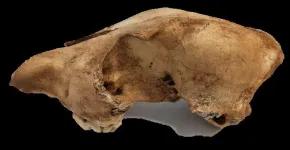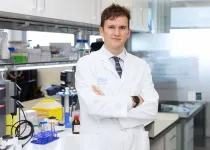(Press-News.org) The human body’s inability to break down sucralose, an artificial sweetener found in many zero-calorie food and drink products, is well established by scientific research. The compound is so stable that it escapes wastewater treatment processing and is in drinking water and aquatic environments.
“We can't break down sucralose, and a lot of microorganisms can't break it down, either, because it's a really tough molecule that doesn't degrade easily. So there are a lot of questions about how it is affecting the environment and whether it’s something that could impact our microbial communities,” said Tracey Schafer, an assistant research scientist for the University of Florida’s Whitney Laboratory for Marine Bioscience and the soil, water and ecosystem sciences department, part of UF’s Institute of Food and Agricultural Sciences.
Schafer is a co-author of a recently published study demonstrating how sucralose affects the behavior of cyanobacteria — an aquatic photosynthetic bacteria — and diatoms, microscopic algae that account for more than 30% of the primary food production in the marine food chain.
Researchers collected soil and water from a freshwater site and a brackish water site in Marineland, Florida. Back at their St. Augustine lab, they exposed samples to different sucralose concentrations and measured photosynthesis and microbial respiration in two separate time studies: every four to six hours during a single day and every 24 hours over the course of five days.
Compared to a control group, the concentration of freshwater cyanobacteria increased when samples were exposed to sucralose, but the concentration of brackish cyanobacteria spiked and then crashed when dosed.
“There is the potential that the freshwater communities might be mistaking sucralose for a nutrient, for a sugar that they can use as food,” said Amelia Westmoreland, the study’s lead author and a scientific researcher who worked on the project while completing her undergraduate degree in chemistry.
Both freshwater and brackish diatoms exposed to sucralose displayed an overall decreasing trend in population compared to a control group. The difference between dosed samples and the control group was most profound, however, in the freshwater experiments.
Sucralose’s ability to both increase and decrease microbial community populations could potentially threaten a naturally balanced ecosystem, Westmoreland said.
“Extreme examples of how this could play out are the diatom community could disappear, and the other extreme is this community could completely overtake everything else,” she said.
Both Schafer and Westmoreland said more research is needed to fully understand sucralose and its impact on aquatic environments.
“I think this study was a good first step in starting to look at how sucralose could impact our aquatic communities, and hopefully it will drive more research forward,” Schafer said.
END
Study reveals environmental impact of artificial sweeteners
2024-07-08
ELSE PRESS RELEASES FROM THIS DATE:
Ancient dingo DNA shows modern dingoes share little ancestry with modern dog breeds
2024-07-08
DNA from fossilised dingo remains going back 2746 years compared with modern dingoes’
Dingos arrived in Australia more than 3000 years ago
K’gari dingoes have no domestic dog ancestry – they are pure dingo
Co-lead author, paleogeneticist Dr Sally Wasef, from QUT’s School of Biomedical Sciences said this dataset gave a rare glimpse into the pre-colonial genetic landscape of dingoes, free from any mixing with modern dog breeds.
“Consequently, are behaviourally, genetically, and anatomically distinct from domestic dogs,” Dr Wasef said.
“Modern-day dingoes’ ancestors arrived in Australia more than 3000 years ...
New director appointed to lead U.S. Department of Energy’s Jefferson Lab
2024-07-08
NEWPORT NEWS, VA – Jefferson Science Associates, LLC, today announced that Kim Sawyer will become the new director of the U.S. Department of Energy’s Thomas Jefferson National Accelerator Facility, effective Aug. 2.
Sawyer will serve as the lab’s fifth director in its 40-year history. In this role, Sawyer will be responsible for leading all activities in support of the world’s premiere research institution for exploring the nature of matter.
“We are pleased that Kim has been selected to lead Jefferson Lab,” said ...
Almost half of US counties have no cardiologists despite higher prevalence of CV risk factors, mortality
2024-07-08
Disparities in cardiovascular disease outcomes between urban and rural areas continue to widen, yet nearly half of U.S. counties do not have a practicing cardiologist. According to a new analysis published in JACC, the flagship journal of the American College of Cardiology, these counties tend to be more rural and socioeconomically disadvantaged, with a greater burden of cardiovascular disease, thus highlighting deep geographic disparity in access to cardiovascular care.
“While cardiologists are not the only determinants of cardiovascular outcomes, the lack of access to cardiologists in areas with ...
Americans find hospital-at-home care appealing and safe
2024-07-08
Hospital-level care provided in a patient’s own home is appealing to a majority of people for its convenience, comfort and effectiveness, according to a USC Schaeffer Center study.
The study, published in JAMA, found that most survey respondents felt they would recover faster if cared for at home, rather than in the hospital, and that they felt safe being treated at home.
Researchers say their study provides important insights about patient and family preferences as policymakers weigh whether to extend ...
A gut microbe could hold a key to help people benefit from healthy foods
2024-07-08
KEY TAKEAWAYS
In a study involving 50,000+ individuals from around the world, higher gut levels of Blastocystis, a single-celled organism commonly found in the digestive system, were linked to more favorable indicators of health.
People with a healthy diet had higher levels of Blastocystis.
The study, which was conducted by an international team led by investigators at Massachusetts General Hospital, suggests that Blastocystis may play a beneficial role in how diet impacts health.
In an analysis of more than 50,000 individuals from around the world, carriers of gut Blastocystis, a single-celled organism that has been ...
Luther identifying road segments that bisect predicted movement corridors for small priority species in Virginia
2024-07-08
David Luther, Associate Professor, Biology, received funding for the project: “Identifying Road Segments that Bisect Predicted Movement Corridors for Small Priority Species in Virginia.”
The purpose of this study is to advance the work of the legislated Wildlife Corridor Action Plan (WCAP) and meet the intent of an awarded Federal Highway Administration (FHWA) grant by identifying road segments that may pose a high risk or impede movement of select small terrestrial and semiaquatic animal species that are ...
Employees prefer human performance monitors over AI, study finds
2024-07-08
ITHACA, N.Y. - Organizations using AI to monitor employees’ behavior and productivity can expect them to complain more, be less productive and want to quit more – unless the technology can be framed as supporting their development, Cornell University research finds.
Surveillance tools cause people to feel a greater loss of autonomy than oversight by humans, according to the research. Businesses and other organizations using the fast-changing technologies to evaluate employee behaviors should consider their unintended consequences, which may prompt resistance and hurt performance, the researchers say. They also suggest an opportunity to win buy-in, ...
Novel liquid biopsy methodology enables the monitoring of disease evolution in patients with metastatic prostate cancer
2024-07-08
Novel liquid biopsy methodology enables the monitoring of disease evolution in patients with metastatic prostate cancer
Extracellular vesicles shed by prostate cancer cells to the bloodstream contain tumor-derived material that can be used as biomarkers of therapy response and resistance in patients with metastatic disease.
Published today in the journal Cancer Cell, results of a VHIO-led study show that a newly developed liquid biopsy-based approach can monitor tumor gene expression through RNA contained ...
Schrag studying history Of Dulles Corridor Metrorail Project
2024-07-08
Zachary Schrag, Professor, History and Art History, College of Humanities and Social Sciences (CHSS), received funding for the project: “Rail Against Sprawl: A History of the Dulles Corridor Metrorail Project.”
Schrag said, “I am writing the history of the Dulles Corridor Metrorail Project, among the nation’s most ambitious efforts to reshape daily transportation choices. After decades of planning and construction, the project was completed in 2022, extending the Washington ...
Study identifies racial and gender disparities in youth psychiatric emergency department boarding
2024-07-08
A new study led by researchers at McLean Hospital and Harvard Medical School, in collaboration with researchers from Massachusetts General Hospital and Cambridge Health Alliance, has uncovered concerning disparities in boarding rates of children and adolescents with severe mental health symptoms in emergency departments.
When reviewing more than 4,900 boarding episodes of youth under 17 years old in Massachusetts over an 18-month period, the researchers found there were numerous racial and gender disparities: Black youth were less likely to be admitted to inpatient psychiatric care than White youth. Additionally, transgender and nonbinary youth experienced ...


